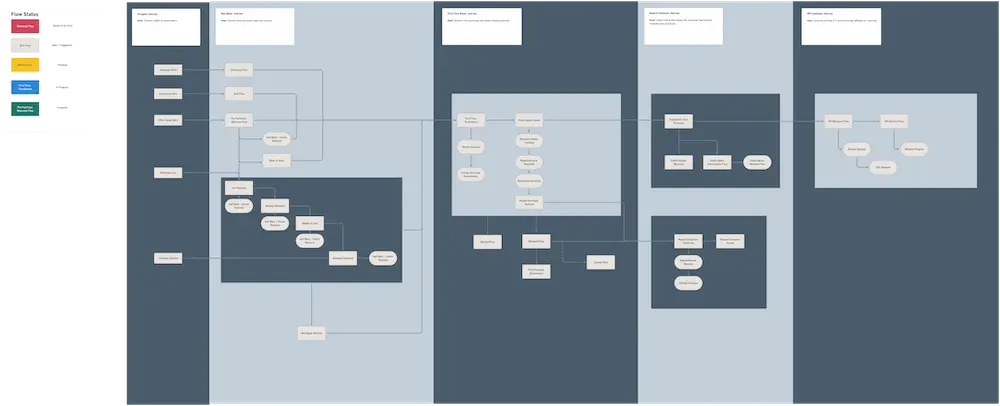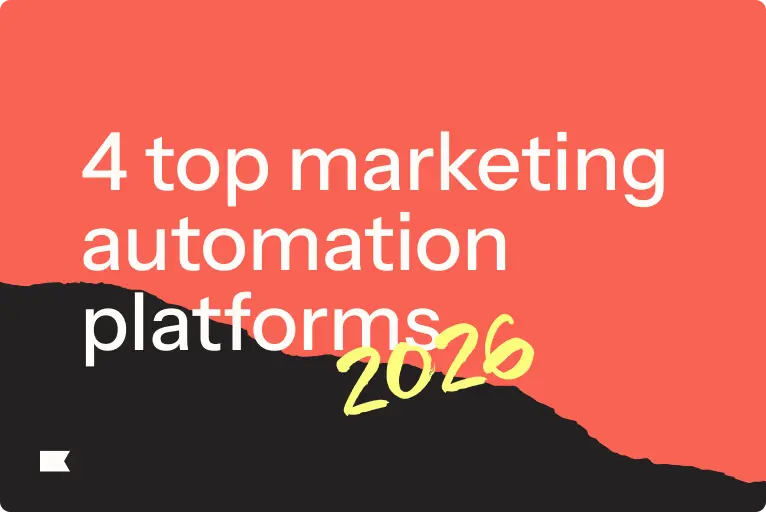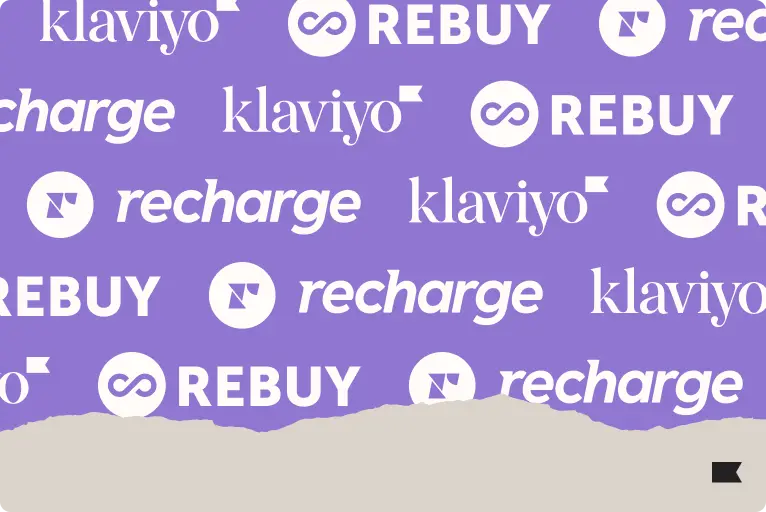Customer journey mapping: the ultimate guide to unlocking email marketing revenue

The most successful B2C brands aren’t just selling products—they’re building lasting customer relationships.
As customer acquisition costs rise and consumer expectations evolve, B2C leaders face immense pressure to deliver seamless, personalized experiences while managing fragmented data and disconnected marketing tools. Traditional CRMs fail B2C businesses due to B2B bias and siloed, channel-first approaches that can’t meet the pace of consumer demands.
Customer journey mapping isn’t just another marketing buzzword—it’s the strategic foundation that separates high-performing email programs from those that struggle to move beyond basic automation.
If you’re feeling stuck with your current flows, unsure what to build next, or watching competitors pull ahead, the solution isn’t more complex tactics. It’s getting clarity on the complete customer experience through strategic journey mapping.
As cofounder of FlowCandy, an email and lifecycle marketing service that specializes in helping ecommerce brands accelerate and systematize their Klaviyo growth, I work with my team to guide brands through customer journey mapping to make sure they have a deep understanding of what their audience experiences.
This is where Klaviyo transforms the game. As the only CRM purpose-built for B2C, Klaviyo is an all-in-one platform with a built-in customer data platform, 1:1 personalization capabilities, and native marketing and service tools—all designed specifically for the unique demands of B2C customer relationships.
Read on for everything you need to know about customer journey mapping.
What is customer journey mapping?
Customer journey mapping is a visual representation of every touchpoint, interaction, and communication a customer has with your brand—from initial awareness through becoming a loyal advocate. Unlike individual email flows that operate in isolation, journey maps reveal the interconnected experience that drives customer behavior and lifetime value (LTV).

Image source: FlowCandy
Why journey maps are essential for email marketing success
Think of customer journey mapping as your email marketing GPS. Without it, you’re making reactive decisions based on incomplete data. With it, you have a clear roadmap showing exactly where your customers are, where they need to go, and what’s preventing them from getting there.
“Customer journey mapping isn’t just a nice-to-have,” says Mike Tatum, lifecycle marketing lead at PrismFly, an ecommerce retention agency. “It’s the backbone of any email strategy that actually moves the needle. Once you see the full picture, you stop guessing and start building flows that drive real revenue and loyalty.”
The problem with flow-by-flow thinking
Most brands approach email marketing by building individual flows in isolation—a welcome series here, an abandoned cart sequence there. This fragmented approach creates several critical problems:
- Missed revenue opportunities: Without seeing the complete picture, you can’t identify gaps where customers are falling through the cracks.
- Inefficient resource allocation: You might spend weeks optimizing a flow that has minimal impact while ignoring high-leverage opportunities.
- Poor customer experience: Disconnected flows create jarring transitions and mixed messaging that confuses customers.
- Team communication issues: Without a shared visual reference, team members waste time explaining individual flows instead of focusing on strategy.
“Building flows in isolation is like patching holes in a boat without checking to see that it floats,” says Midge Hazelwinkel, head of Klaviyo at Code, a Shopify Plus agency in The Netherlands. “You lose sight of the goal.”
Building flows in isolation is like patching holes in a boat without checking to see that it floats.
The journey map solution
Journey mapping solves the problems listed above by providing a bird’s-eye view of your entire customer experience. This perspective empowers you to:
- Identify exactly which flows to build next based on customer behavior patterns.
- Spot experience gaps that, when fixed, dramatically improve metrics like LTV and Net Promoter Score (NPS).
- Optimize underperforming flows by understanding their role in the broader customer journey.
- Communicate strategy efficiently across teams.
- Integrate new platforms and channels strategically rather than reactively.
“Brands should design their flow library holistically, with clear objectives for each one: earning trust, preventing churn, and building long-term connections,” Hazelwinkel continues. “When done right, this approach doesn’t just improve the experience. It drives measurable lifts in engagement, repeat purchases, and LTV.”
The 5 core customer journeys
Every successful email marketing program should map 5 distinct customer journeys, each with specific goals and optimization strategies:
1. Prospect journey
Goal: Convert website traffic into email or SMS subscribers.
The prospect journey focuses on your lead generation ecosystem—forms, opt-ins, sign-up incentives, and initial touchpoints. This journey is all about maximizing your subscriber acquisition rate and making sure you’re capturing leads at every relevant touchpoint.
Key components:
- High-quality forms and pop-ups optimized for conversion
- Logic-based triggers that respond to customer behavior
- Lead magnets aligned with traffic sources
- Capture points on all high-traffic pages
Success metrics: form conversion rate, subscriber growth rate, cost per acquisition
“Subscriber growth isn’t just about having a pop-up,” says David Visser, CEO of Zyber and Unlocked, ecommerce growth agencies in New Zealand. “It comes down to finding the incentive to sign up that converts best. Depending on your brand strategy, you can test whether a percentage off, a free gift, or exclusive access drives the highest sign-up conversion.”
Subscriber growth isn’t just about having a pop-up.
2. Non-buyer journey
Goal: Convert subscribers into first-time customers.
This journey encompasses your foundational pre-purchase flows, including welcome series, browse abandonment, and cart abandonment sequences. The focus is on addressing every possible objection or hesitation that prevents a first purchase.
Key components:
- Welcome series that introduces your brand value proposition
- Browse abandonment flows that re-engage interested prospects
- Cart abandonment sequences that address purchase hesitations
- Educational content that builds trust and authority
Common objections to address:
- Price concerns and value justification
- Frequently asked questions about products or policies
- Social proof through reviews and testimonials
- Customer support accessibility
- How-to content that demonstrates product value
- User-generated content (UGC) and unboxing experiences
Success metrics: first-time buyer conversion rate, time to first purchase, welcome series engagement rates
3. First-time buyer journey
Goal: Provide an exceptional post-purchase experience and drive a second purchase.
The first-time buyer journey is critical for customer retention and LTV growth. This journey focuses on exceeding expectations during the initial purchase experience while strategically introducing opportunities for additional purchases.
Key components:
- Order confirmation and shipping notifications that build excitement
- Educational content that maximizes product satisfaction
- Feedback collection to identify improvement opportunities
- Strategic cross- and up-sell recommendations
Essential tactics:
- Personalized transactional emails that extend the brand experience
- Detailed shipping notifications that manage expectations
- CEO welcome letters that add a personal touch
- Bounce-back offers for immediate additional purchases
- NPS surveys to measure satisfaction
- Referral program introductions
- UGC and review collection
- Subscription upgrade offers where relevant
Success metrics: second purchase rate, customer satisfaction scores, average order value (AOV)
“UGC isn’t just social proof,” says Visser. “It’s a growth lever. People love seeing real customers using your product instead of only polished marketing. Rewarding reviews with a next-order discount or gift can turn that feedback into repeat purchases.”
UGC isn’t just social proof—it’s a growth lever.
4. Repeat buyer journey
Goal: Increase purchase frequency and AOV.
Repeat buyers represent your most valuable customer segment. The repeat buyer journey focuses on deepening engagement, increasing purchase frequency, and maximizing LTV through strategic up- and cross-selling.
Success metrics: purchase frequency, AOV, LTV, retention rate
5. VIP journey
Goal: Create raving fans who become brand advocates.
VIP customers are your brand evangelists—customers so satisfied they organically recommend your products to friends and family. This journey focuses on exclusive experiences, early access, and advocacy opportunities.
Success metrics: referral rate, UGC volume, brand mentions, VIP segment growth
5 proven journey mapping tactics
Tactic 1: Identify next flows to build
The strategy: Use pre-built journey map templates to instantly identify missing flows in your current set-up.
Create templates for different business models, like:
- General ecommerce: standard flows applicable to most online retailers
- Subscription: specialized flows for subscription-based businesses
- Apparel: fashion-specific flows addressing seasonal trends and sizing concerns
Implementation process:
- Select the template that best matches your business model.
- Overlay your current flows onto the template.
- Identify gaps where flows are missing or underdeveloped.
- Prioritize flow development based on potential impact and implementation difficulty.
Expected outcome: a clear roadmap of flows to build, resulting in immediate revenue increases as new automation captures previously lost opportunities
Tactic 2: Identify customer experience gaps
The strategy: Use journey mapping to spot friction points and experience gaps that impact customer satisfaction and LTV.
Advanced implementation: Combine journey mapping with value chain analysis to understand how each touchpoint contributes to overall customer value perception.
Key areas to examine:
- Transition points between different customer stages
- Communication gaps where customers receive no contact for extended periods
- Inconsistent messaging or tone across different flows
- Missing support or educational content during critical decision points
Expected outcome: improved customer satisfaction scores, increased LTV, and higher average NPS through enhanced experience optimization
“In my experience,” Tatum shares, “the biggest wins come from identifying those invisible gaps—meaning, the places where customers get lost or frustrated. A good journey map turns those blind spots into opportunities for growth, and you feel the impact in your bottom line.”
Tactic 3: Optimize underperforming flows
The strategy: Use team journey mapping sessions to identify and prioritize optimization opportunities for existing flows.
Implementation process:
- Gather key stakeholders for collaborative journey mapping sessions.
- Identify flows with below-benchmark performance metrics.
- Analyze each underperforming flow’s role in the broader customer journey.
- Determine whether poor performance stems from flow content, timing, or positioning within the journey.
- Prioritize optimization efforts based on potential impact and resource requirements.
Expected outcome: increased conversion rates and sales from existing flows, plus optimized resource allocation from focusing on highest-impact improvements
Tactic 4: Streamline team communication
The strategy: Use journey maps as shared reference documents to eliminate confusion and improve strategic alignment across teams.
Implementation best practices:
- Pin journey maps in team communication channels (Slack, Teams, etc.).
- Use maps during strategy meetings to maintain focus on customer experience.
- Reference specific journey stages when discussing individual campaigns or flows.
- Update maps regularly to reflect current strategy and performance insights.
Expected outcome: less time spent explaining individual flows, better strategic alignment, and faster decision-making across marketing, customer service, and product teams
“Teams that use journey maps don’t just send better emails,” says Tatum. “They communicate better, make smarter decisions, and deliver a more seamless experience. It’s the difference between playing checkers and playing chess.”
Teams that use journey maps don’t just send better emails—it’s the difference between playing checkers and chess.
Tactic 5: Integrate new platforms and channels
The strategy: Use journey mapping to identify strategic opportunities for expanding beyond email into SMS, direct mail, loyalty programs, and other marketing channels.
Key insight: Not every marketing message should be an email, and not every email should come from your primary marketing platform. Journey mapping reveals where alternative channels or platforms might deliver superior results.
Integration opportunities:
- SMS for time-sensitive communications and mobile-first experiences
- Direct mail for high-value customer segments or special occasions
- Loyalty programs for repeat buyer and VIP journey optimization
- Push notifications for app-based businesses
- Social media retargeting aligned with email sequences
Expected outcome: diversified marketing channel mix that improves overall campaign performance and provides additional revenue streams
Building your journey map: tools and best practices
Recommended tools
Primary recommendation: Whimsical
- Purpose-built for visual mapping and collaboration
- Intuitive interface that non-technical team members can use
- Strong collaboration features for team mapping sessions
Alternative options:
- Miro: excellent for collaborative whiteboarding and complex journey mapping
- Lucidchart: professional diagramming with advanced features
- Any wireframing tool: Figma, Sketch, or similar design tools
Key tool requirements:
- Easy accessibility for all team members
- Real-time collaboration capabilities
- Visual clarity that makes complex journeys understandable at a glance
Implementation best practices
- Start with customer goals, not business goals. Your journey map should reflect what customers are trying to accomplish, not what you want them to do. This customer-centric approach reveals authentic optimization opportunities.
- Map actual behavior, not ideal behavior. Use real data from your email platform, website analytics, and customer feedback to understand how customers actually move through your experience, not how you think they should move.
- Include all touchpoints. Don’t limit your mapping to email communications. Include website visits, customer service interactions, social media engagement, and any other relevant touchpoints.
- Make it actionable. Every journey map should result in specific, actionable improvements. Avoid creating maps for the sake of mapping. Focus on insights that drive measurable results.
Critical success factors
Product and service foundation
Journey mapping amplifies your existing customer experience. It cannot fix fundamental product or service issues. Before investing heavily in journey optimization, make sure you have:
- Products that deliver genuine value to customers
- Reliable fulfillment and shipping processes
- Responsive customer service that resolves issues effectively
- Consistent brand experience across all touchpoints
No flow, funnel, or tactic can counteract a poor first experience. Make good products. Have great customer service when fulfilling those products.
Focus on creating raving fans
The ultimate goal of every customer journey should be creating “raving fans”—customers so satisfied they organically recommend your products to friends and family. This way, your journey mapping efforts contribute to sustainable, long-term growth rather than short-term revenue optimization.
Here are a few ways to measure this:
- LTV growth
- Repeat purchase segment expansion
- VIP customer segment growth
- UGC volume
- Online review quantity and quality
- NPS improvements
- Organic referral rates
“Think about the brand, artist, or community you’re most passionate about,” suggests Visser. “What makes you feel so valued that you rave about them to your friends? That’s the kind of belonging brands should aim to create if they want customers who stick around and advocate for them.”
Getting started: your journey mapping action plan
Phase 1: Assessment and foundation (weeks 1–2)
- Audit your current flows. Document all existing email flows and their performance metrics.
- Select your mapping tool. Choose and set up your journey mapping platform.
- Gather team input. Interview customer service, sales, and product teams about common customer questions and pain points.
- Collect customer data. Analyze customer behavior data, survey responses, and feedback to understand actual journey patterns.
Phase 2: Core journey development (weeks 3–6)
- Map the prospect journey. Start with lead generation and subscriber acquisition.
- Map the non-buyer journey. Focus on converting subscribers into first-time buyers.
- Map the first-time buyer journey. Optimize the post-purchase experience and second purchase conversion.
- Identify quick wins. Spot immediate opportunities for new flows or experience improvements.
- Prioritize development. Create your implementation roadmap based on impact and resource requirements.
Phase 3: Implementation and optimization (week 7 and beyond)
- Build priority flows. Implement highest-impact missing flows first.
- Test and iterate. Use A/B testing to optimize new and existing flows.
- Monitor performance. Track key metrics to measure journey mapping impact.
- Expand integration. Gradually integrate additional channels and platforms.
- Review regularly. Schedule quarterly journey mapping review sessions to identify new opportunities.
Measuring journey mapping success
Primary revenue metrics
- Email marketing revenue growth: overall increase in revenue attributed to email marketing
- Flow revenue increase: specific revenue gains from new and optimized flows
- LTV: long-term value improvement from enhanced journeys
Customer experience metrics
- NPS: customer satisfaction and advocacy
- Customer retention rate: percentage of customers making repeat purchases
- Average time between purchases: frequency improvement in repeat buying behavior
Operational efficiency metrics
- Team communication time: reduction in time spent explaining flows and strategy
- Campaign development speed: faster implementation of new marketing initiatives
- Cross-team alignment: improved collaboration between marketing, customer service, and product teams
Transform your email marketing with strategic journey mapping
Customer journey mapping represents a fundamental shift from tactical email marketing to strategic customer experience design. By implementing the 5 core journeys and 5 proven tactics outlined in this guide, you’ll transform disconnected email flows into a cohesive system that drives measurable revenue growth and creates lasting customer relationships.
The brands that master journey mapping don’t just send better emails. They use their CRM to create experiences that turn customers into raving fans who drive organic growth through word-of-mouth recommendations.
Start with mapping your prospect journey, identify your biggest gaps, and build from there. Your customers—and your revenue—will thank you for it.

Related content

Discover the best marketing automation platform for 2026 and learn how to choose based on data, integrations, scalability, and the features that drive real customer value.

Discover 4 proven ways to reduce cart abandonment and recover lost sales. Learn how to build trust, streamline check-out, and personalize abandoned cart flows to convert more shoppers.

Looking for the best Shopify apps for marketing and customer service? Klaviyo, Rebuy, and Recharge together create a high-performing tech stack that revenue and customer retention.